Tracing the Legacy of Egyptian Blue: From Ancient Artifacts to Modern Insights
Egyptian blue, known in the scientific community as calcium copper silicate, has come to be recognized as a pioneering feat of human creativity. With origins speculated to precede 3000 BC, Egyptian blue was first created in ancient Egypt, making it one of the earliest artificial pigments known to humanity. It is also a pigment that is remarkably resistant to fading, even after thousands of years.
Excavations of ancient Egypt have revealed that Egyptian blue was utilized extensively in art and religious contexts, adorning statues, tomb paintings and sarcophagi. Crafting it required a delicate balance of calcium compounds, copper materials and silica sand, showcasing ancient mastery of chemistry. Even today, its optical properties continue to intrigue scientists, who are still finding new applications for its unique characteristics. From biomedical imaging to advanced communication technologies, Egyptian blue remains a source of inspiration for modern innovation.
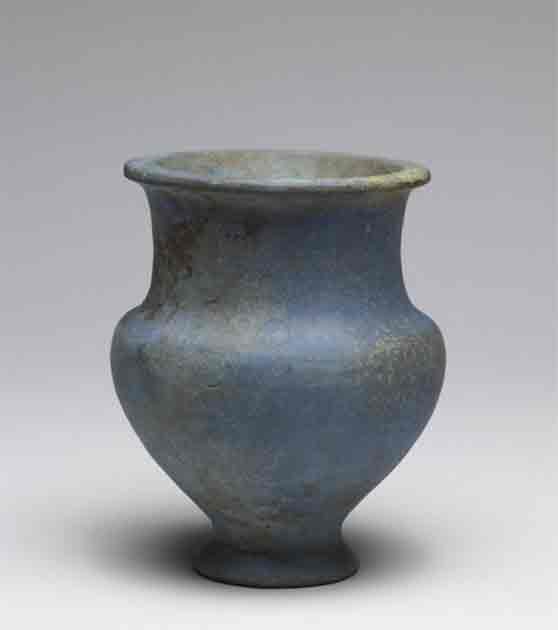
Example of Egyptian blue ceramic ware from the New Kingdom of Egypt, circa 1380 to 1300 BC. (Public domain)
Unveiling the Antiquity of Egyptian Blue: A Historic Hue
Evidence of Egyptian blue can be found on limestone sculptures, cylinder seals, beads, wall paintings and statues. The oldest known example of the exquisitely colored pigment is said to be about 5,000 years old, found in a tomb painting dated to the reign of Ka-Sen, the last pharaoh of the First Dynasty.
Others, however, state that the earliest evidence of the use of Egyptian blue is from the Fourth Dynasty and the Middle Kingdom, around 4,500 years ago. Nevertheless, some scholars argue that its widespread use began during the Middle Kingdom period, which started around 4,000 years ago. More recent research has even posited that Egyptian blue was not an Egyptian invention at all, but was originally brought over from Mesopotamia or Syria.
- Han Purple: The 2,800-Year-Old Mystery Solved by Quantum Physicists
- Eco-Architecture in Egyptian Blue: Scientists Discover Modern Usage for the 4,000-Year-Old Pigment
Whenever it was first used, by the time of the New Kingdom, from around 1550 BC to 1070 BC, Egyptian Blue was commonly used as a pigment in painting and can be found on statues, tomb paintings and sarcophagi. Its characteristic blue color, resulting from one of its main components—copper—ranged from a light to a dark hue, depending on differential processing and composition.
When ground coarsely, the pigment produced a rich, dark blue, while very finely-ground pigment produced a pale, ethereal blue. It was created by heating a mixture of a calcium compound (typically calcium carbonate), a copper-containing compound (metal filings or malachite), silica sand and soda or potash as a flux, to around 850 to 950 degrees Celsius.
Egyptian blue pigment was also often used as a coloring agent in ancient Egyptian faience objects, a kind of ceramic adorned with intricate designs, often glazed with vibrant colors. The pigment was commonly incorporated into the ceramic material to achieve various shades of blue, ranging from light to dark hues. Egyptian blue added vibrancy and depth to the color palette of faience objects, enhancing their aesthetic appeal.
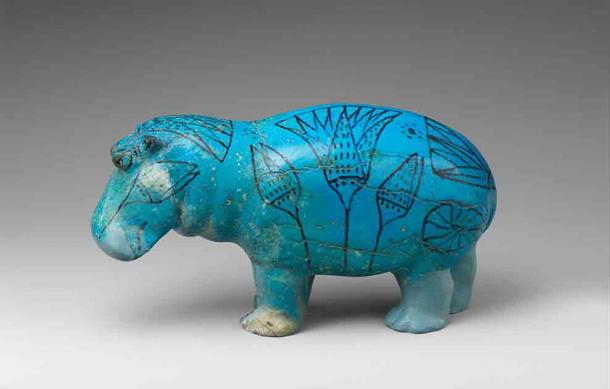
Egyptian blue faience statuette of a hippopotamus, circa 1961 to 1878 BC. (Public domain)
Egyptian Blue in Ancient Egyptian Belief Systems
In ancient Egyptian belief systems, the color blue held profound significance, representing the heavens, the vast expanse of the universe, and the life-giving waters of the River Nile. This celestial hue symbolized life, fertility and rebirth, embodying the cyclical nature of existence. While other colors like reds, yellows and browns were readily available, blue held a special allure due to its rarity and association with divine entities. The deep blue semi-precious stone lapis lazuli, imported from Afghanistan, served as a luxury item for the Egyptians, its rich color ideal for depicting their revered deities.
To replicate the precious blue of lapis lazuli, ancient Egyptian artisans sought to produce a synthetic pigment, resulting in the creation of Egyptian blue. Historians believe that Egyptian blue came about as a result of deliberate experimentation and refinement by skilled craftsmen in ancient Egypt.
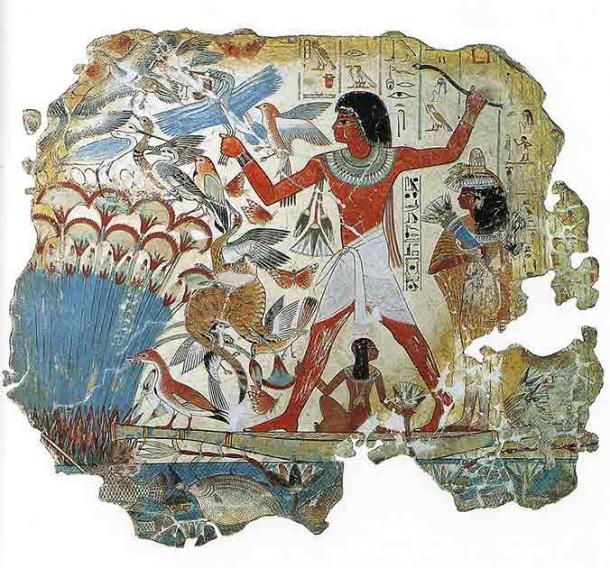
Wall painting with Egyptian blue from the 18th Dynasty tomb of Nebamun (1567 to 1320 BC). (Public domain)
Ancient Egyptian Production of Egyptian Blue
Known production centers for Egyptian blue were indeed established in cities like Amarna and Memphis, where skilled craftsmen meticulously crafted this revered pigment. Archaeological excavations at these sites have uncovered workshop remains, including kilns and tools used in the pigment production process. Analysis of these artifacts, alongside scientific studies of the chemical composition of Egyptian blue samples, has provided valuable insights into the production techniques employed by ancient artisans.
The production process of Egyptian blue required a precise combination of raw materials. Calcium compounds, likely sourced from limestone or gypsum, formed the base for the pigment, while copper materials, such as malachite or copper ores, were added to impart its characteristic blue color. Silica sand acted as a stabilizing agent, and fluxes like natron or plant ash helped lower the mixture's melting point during firing.
By carefully controlling the proportions of these ingredients and heating them to specific temperatures, artisans could achieve the desired hue of Egyptian blue pigment. However, while we have a general understanding of the production process based on available evidence, the exact techniques used by ancient craftsmen may vary and are not always fully understood. The process undoubtedly required skill and expertise to ensure consistency in color and quality. Over generations, through experimentation and refinement, ancient craftsmen perfected the production of Egyptian blue, creating a pigment that became highly prized and widely used in ancient Egyptian art and culture.
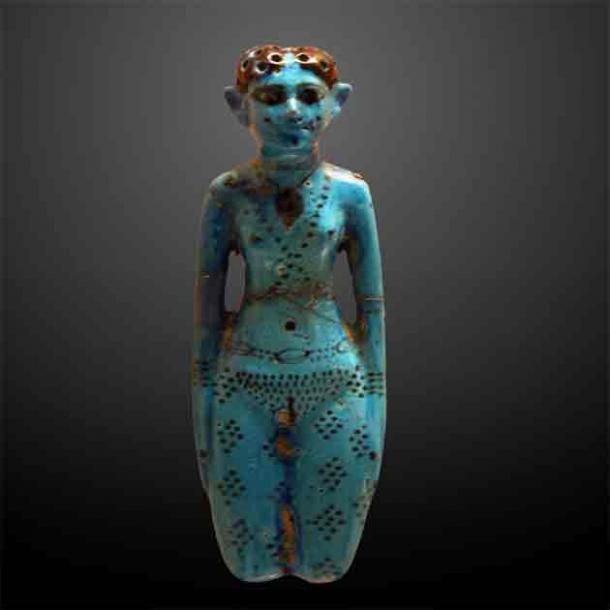
Naked woman with tattoos from circa 2033 and 1710 BC on display at the Louvre Museum. (Louvre Museum / CC BY-SA 2.0 FR)
Egyptian Blue Beyond the Borders of Egypt
The allure of Egyptian blue indeed extended far beyond the borders of Egypt, influencing artistic traditions throughout the Mediterranean region. Remnants of Egyptian blue pigment have been discovered in numerous Greek and Roman artifacts, attesting to its widespread use and significance in ancient art.
For example, traces of blue pigments have been found on statues from the Parthenon in Athens, suggesting the use of blue in ancient Greek sculptures. Similarly, wall paintings in Pompeii, the Roman city buried by the eruption of Mount Vesuvius, also show evidence of blue pigments, reflecting the adoption of blue hues in Roman artistic practices. While it's not definitively proven that these pigments are Egyptian blue, they indicate the widespread use of blue pigments in both ancient Greek and Roman art.
- Invisible Blue: The Color That Ancient People Could Not See
- Ancient Egyptian Blue Pigment Revolutionizes Biomedicine
Moreover, historical records and archaeological findings provide further evidence of the spread of Egyptian blue beyond Egypt. Trade networks and cultural exchanges facilitated the dissemination of this prized pigment throughout the ancient world. Egyptian blue pigments have been unearthed in various archaeological sites across the Mediterranean, such as Cyprus, Crete, and Italy, underscoring its popularity and widespread use among different civilizations.
Despite its extensive application in art across different cultures and time periods, the method of producing Egyptian blue was eventually forgotten with the decline of the Roman Empire. As artistic practices evolved and new materials became available, the use of Egyptian blue gradually faded away. Nonetheless, Egyptian blue remains a testament to ancient craftsmanship and spiritual symbolism, leaving an indelible mark on the history of art and culture.
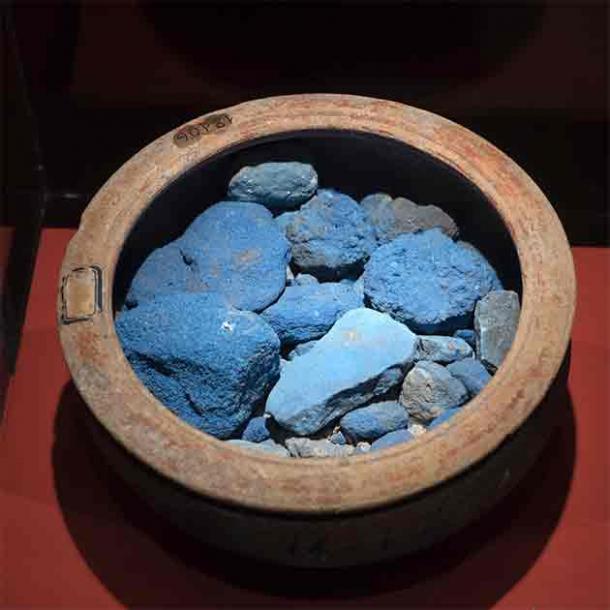
Cup containing Egyptian blue pigment from Pompeii. (Dan Diffendale / CC BY-NC-SA 2.0 DEED)
The Rediscovery of Egyptian Blue in Modern Times
It was only in the 19th century that Egyptian blue was rediscovered. Excavations at Pompeii revealed that many wall paintings had Egyptian blue on them. Additionally, the discovery of a blue pigment within an artist’s shop in 1814 prompted scientists to investigate the exact composition of this elusive pigment. The sample was sent off to the Royal Institution in London to be analyzed by Sir Humphry Davy, who concluded it was of Egyptian origin. Later analysis by Ferdinand Fouqué, a French geologist, found that it had been created with a complex copper compound.
Since then, researchers have gained a much deeper understanding of its unique properties. Experiments have found that Egyptian blue has the highly unusual quality of emitting infrared light when red light is shone onto it. This emission is extraordinarily powerful and long-lived, but cannot be seen by the naked eye, because human vision does not normally extend into the infrared range of the light spectrum.
In addition, scientists unexpectedly discovered that Egyptian blue will split into nanosheets—a thousand times thinner than a human hair—if stirred in warm water for several days. Scientists now believe that its unique properties may make Egyptian blue suitable for a variety of modern applications.
As such, Egyptian blue may one day be utilized for communication purposes, as its beams are similar to those used in remote controls and telecommunication devices. Moreover, Egyptian blue could be used in advanced biomedical imaging, as its near-infrared radiation is able to penetrate through tissue better than other wavelengths.
As an ink solution, Egyptian blue opens up new ways for its incorporation into modern appliances, such as the development of new types of security ink and possibly as a dye in the biomedical field. While the utilization of Egyptian blue in modern high-tech applications is currently in its early stages, the outlook for its future appears promising.
Top image: Representative image of Egyptian blue pigment. Source: Pattadis / Adobe Stock
By Wu Mingren
References
Boddy-Evans, A., 25 January 2019. “Colors of Ancient Egypt” in ThoughtCo. Available at: https://www.thoughtco.com/colors-of-ancient-egypt-43718
Choi, C. Q., 11 March 2013. “Ancient Egyptian Pigment's Future Now Even Brighter” in Inside Science. Available at: https://www.insidescience.org/content/ancient-egyptian-pigments-future-now-even-brighter/954
Errington, B. et. al. 2016. “Micronised Egyptian blue pigment: A novel near-infrared luminescent fingerprint dusting powder” in Dyes and Pigments, Volume 132, pp. 310-315. Available at: https://doi.org/10.1016/j.dyepig.2016.05.008
Gayle, D. 22 February 2013. “Talk like an Egyptian: Ancient paint used to decorate Pharoahs' tombs is set to be the basis of telecommunication devices” in Mail Online. Available at: http://www.dailymail.co.uk/sciencetech/article-2282993/How-Ancient-Egypts-synthetic-pigment-set-enjoy-renaissance-high-tech-nanomaterial.html
Meier, A. 3 April 2017. “Egyptian Blue: The First Synthetic” in Hyperallergic. Available at: https://hyperallergic.com/366307/egyptian-blue-the-first-synthetic-pigment/
McCouat, P. 2014. “Egyptian Blue: The Colour of Technology” in Journal of Art in Society. Available at: https://www.artinsociety.com/egyptian-blue-the-colour-of-technology.html
Pain, S. 22 January 2000. “Something blue…” in NewScientist. Available at: https://www.newscientist.com/article/mg16522224-800-something-blue/
Pigments through the Ages, 2014. “Egyptian Blue” in Pihments through the Ages. Available at: http://www.webexhibits.org/pigments/indiv/overview/egyptblue.html
Swaminathan, N. May/June 2013. “From Egyptian Blue to Infrared” in Archaeology. Available at: https://www.archaeology.org/issues/90-1305/trenches/741-ancient-egypt-blue-pigment-modern-applications




















Comments
“In Egyptian belief, blue was considered as the colour of the heavens, and hence the universe.”
Might also have some basis for the ancient Greek reverence for blue-eyed, blondes, as their ‘gods’ were typically depicted. As per Plato, Thebes would once have been quite a site to see, ...with all the ‘tall blondes’. But oh, how things change!
Nobody gets paid to tell the truth.
I have noticed this kind of difference viewing images from some tombs of ancient Egyptian especially the one in Dendera and Medinet Habu temple in Luxor, both have really strange BLUE.
there was extensive research done by egyptians to come up with this invented color or paint. i believe the ancient silk road connected china to egypt and soon after india and turkey was how the formula spread.
it is most doubted a similar idea of such chemical research back at that time was developed separately,
Most likely, it was shared as result for need of trade, the silk road provided that connection. as i bet many colors were produced soon after by sharing ideas.
could also be a parallel development.
Pages